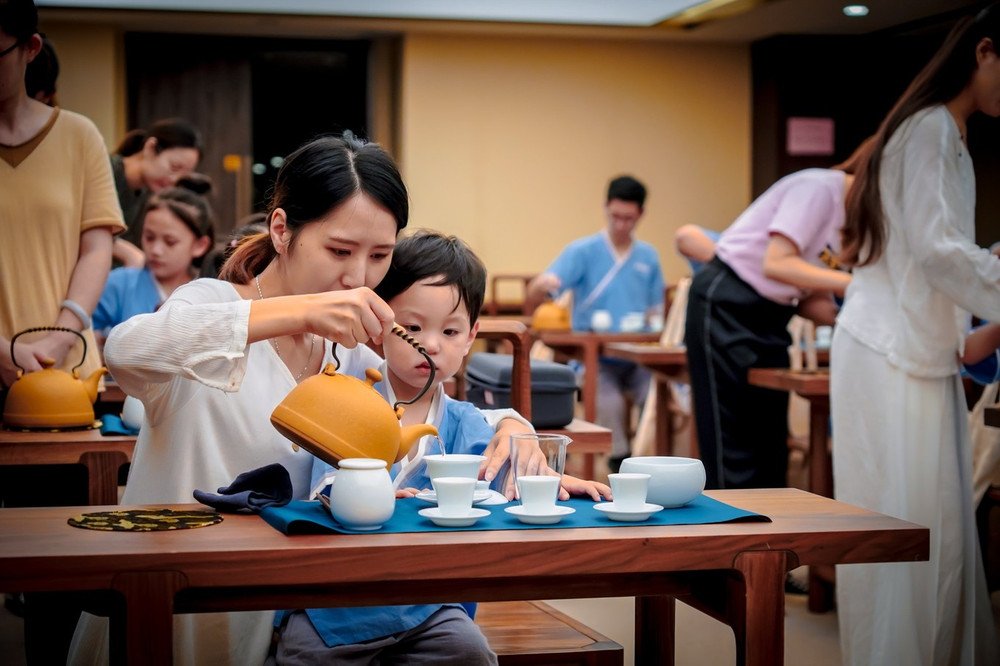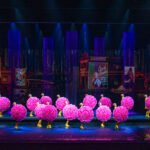Duration: 2 days, Time: August, Cost per person: 1000 yuan, With whom: Parent-child, Style of play: Cultural, Weekend getaway, Author visited these places: Shanghai, Published on 2020-08-28 01:02. “Mom, where does tea come from?” “A single leaf falling into water, changing its taste, and thus, tea was born.” Perhaps it’s an obsession with Chinese traditional culture, but I always hope to incorporate more elements of Chinese culture into my travel plans with my child. So, when invited by a friend to experience tea culture, I gladly accepted. As the birthplace of tea, I naturally wish to plant a small seed in his heart from a young age, waiting for it to slowly sprout and fill the air with the fragrance of tea. Thus, a journey in pursuit of traditional Chinese tea etiquette culture began. This was a two-day trip, and rather than hoping that the child would understand tea in these two days, I hoped more for him to understand etiquette. The etiquette of tea ceremony and Chinese etiquette share a common origin, and I hope that my child, through learning the art of tea, would exercise his focus and cultural refinement in the process of doing and thinking. In the morning, starting from the urban area of Shanghai, it took about an hour’s drive to reach the Tai Life Culture Park. As a native of Shanghai, I was unfamiliar with this place, but after visiting, I was amazed; it is truly a hidden gem within the city, regretting not discovering this paradise sooner. As soon as the car entered the park, I was drawn to the ancient cultural atmosphere of the entire cultural park. The Vajra Museum, Mingyue Tea Fairy, ancient buildings, and the world of colored glaze, all gather Chinese traditional culture here. From art exhibitions to tea culture to ancient architecture, the integration of tea, Zen, and art makes this garden more like a place for cultural and artistic retreat. We drove straight to the hotel, Tai Hotel, which is also part of Tai Life Culture Park, and the children’s tea etiquette class is held here as well, making it very convenient to enter the hotel lobby. The modern Chinese style design is simple and elegant, and the entire air is filled with the scent of tea. The tea culture elements visible everywhere in the room, from tea fragrances and soaps to tea utensil decorations, showcase the ancient elegance and refinement of Chinese traditional culture. At the front desk, we picked up the teaching materials for the entire course, and surprisingly found a set of tea costumes, prepared for the children. In the room, we dressed the baby in the costume, officially starting the two-day journey into the world of children’s tea etiquette. The etiquette of tea culture has not yet started class, but the children have already arrived one after another, wearing their little tea costumes, and have already entered the classroom to play. For them, this is not just a course, but also a place to make friends. Children are truly innocent; running around and chasing each other for a couple of laps, and they all become acquainted.
The course starts punctually at 10 o’clock. The teacher begins to call on them to line up outside the classroom. The students line up in four columns from short to tall, wearing tea costumes and carrying their own small schoolbags, which is quite ceremonial. But it’s not so easy to enter the classroom. Courtesy comes first in everything. For China, a country of etiquette, etiquette in tea activities is also a very important part. Therefore, ‘tea ceremony’ becomes their first lesson. And the bow is the first etiquette they learn. As the name suggests, bowing means bending down to salute. This is a relatively formal etiquette and expresses a kind of respect for others. The children learn from the teacher’s appearance and bow and make obeisances. Although they are not yet in order, they also learn quite well. After the children have a preliminary understanding of the bow, the door to ‘children’s tea ceremony’ is officially opened for them. The teachers hold the children’s little hands and line up to enter the classroom and take their seats in turn. The children sit down in their own positions, while parents can listen in on the adjacent area. The children in this session range from less than 2 years old to 16 years old. There are multiple teachers. Perhaps influenced by tea culture, the teachers here all speak softly, are gentle and refined, and take good care of every child gently. Many children are here for the first time, but there are also some children who have come two or three times. Those parents also planted a small seed of tea culture for them when they were young. Now that it begins to germinate, they come to study in depth again. The children who are new here are full of curiosity and can’t contain their joy in their eyes. The teachers said that students who perform well in each link today will have paper tags. Three paper tags can be exchanged for the small tea bags carefully prepared by the teachers for the students. The reward effect is always quite effective for children, and the little ones are more motivated. First Scent of Tea Fragrance – Tea Recognition Chapter She is dressed in plain clothes, with her hair hanging down to her waist. She walks onto the podium with light steps. The children exclaimed ‘Wow!’ ‘It’s the tea fairy!’ The regulars of the children’s etiquette class recognized her first. She smiled faintly. Every gesture and movement is full of composure and elegance. The tea fairy, just as her name suggests, when she holds up a cup and pot, she is as gentle as a fairy coming down from the sky. But after putting down the cup and pot, she seems to have fallen into the mortal world again. More like a mother, she gets along well with the children. The children stand up by the table and perform the bow they just learned to the tea fairy. This session is a tea recognition class. The children take out a book from their backpacks, ‘Tea Fairy | The Joy of Drinking Tea’. This is a book written by the tea fairy herself. The content is easy to understand and is also accompanied by lovely illustrations. The children are like reading picture books.

Starting from a single leaf, the tea fairy teacher leads the children into the colorful world behind tea. Some people may ask, tea culture is something that even adults only know a little about. Can children understand it? Before coming, I was also worried. But when I saw the children answering the questions raised by the tea fairy fluently, I realized that children’s potential is truly infinite. From more than 700 kinds of aromas of tea leaves, to the five flavors of tea, and then to the types of tea, they have quickly mastered all of these in a short time. In order to make the knowledge in books more intuitive, the tea fairy brought six types of tea, namely green tea, white tea, yellow tea, oolong tea, black tea, and dark tea, and let the children come on stage to identify them. At the same time, the tea fairy also personally brewed green tea, yellow tea, and black tea for the children to taste. I don’t know if it is the tea that moistens her, or if it is she who warms the tea. The tea brewed by the tea fairy always has a pleasant aroma. The fragrance of tea leaves remains on the gaiwan. The tea fairy lets the aroma flow past the children’s noses. The children who smell the tea fragrance for the first time can’t help but exclaim, ‘So fragrant!’ Smelling the tea fragrance and observing the color of the tea soup. The children are quite interested in such interactive sessions. Except for my 2-year-old baby who is already a bit impatient. Fortunately, lunchtime is almost here. At noon, everyone has a meal in the hotel’s restaurant. The dishes are carefully designed for the children, with a combination of meat and vegetables, which are very suitable for children’s tastes. The influence of the environment on a child is really powerful. Together with the elder brothers and sisters, my baby who never wants to eat by himself actually picked up a spoon and ate happily one bite after another. After lunch, go back to the room for a nap. Have a good sleep and continue with the afternoon’s courses. At this time, the tea fairy is sitting in front of the tea table, planting a small seed of tea culture in each child’s book. Initial Understanding of Tea Sets – Layout Chapter ‘Making tea is picking up solemnly five hundred times before one can master putting it down gracefully once.’ A sentence given by the tea fairy to the children. If the morning is all about theory classes, then the afternoon is a practical class. The children who already know a little about tea now have their own name tags and a new identity, little tea fairies. Each child received a set of tea sets, which became their treasures. They carefully carried them and returned to their seats. The tea fairy teacher explained on the podium while demonstrating the basic process and etiquette norms of making tea. She slowly put the tea leaves into the gaiwan, poured water, lifted the kettle, soaked, and poured out the tea soup… flowing smoothly and completing it in one go. Every move and gesture fully displays the gentle oriental temperament. Only then did I, who was listening on the side, suddenly understand. This seemingly simple tea art step is actually very particular. The amount of tea leaves, the temperature of the water, and the soaking time will all affect the taste of the tea soup.
As the children eagerly unboxed the tea sets, parents were also asked to assist their little ones on site. The first lesson was about the arrangement of tea utensils. During practice, the teacher prepared cold water for the children, ensuring that beginners would not worry about burns. The Tea Fairy selected the Phoenix Dan Cong ‘Yashi Xiang’ for the children, a peculiar name that is as precious as the cat poop coffee in the coffee world. It was a bit heart-wrenching to see the children handle such fine tea, but the Tea Fairy explained that it was essential for the children’s palates to experience the aroma of tea, to remember the scent of their first sip, so that they could discern the quality of tea in future tastings. The Phoenix Dan Cong is renowned for its fragrance, and even when steeped cold, it can release its rich aroma, making it perfectly suitable. As the children focused on the world of tea art, the entire world seemed to quiet down, their temperaments softened, their minds calmed, and their concentrated expressions resembled little tea fairies. Although their movements were still a bit naive, the teachers personally went to each child to correct and guide their tea brewing process and hand gestures. My son Kaikai also solemnly imitated the process, smelling the tea fragrance after brewing and taking a small sip, then sweetly exclaiming, ‘Fragrant!’ Brewing tea is not an easy task, as the Tea Fairy teacher told the children, ‘Brewing tea is about picking it up with solemnity 500 times to master the grace of putting it down effortlessly.’ To achieve a graceful demeanor, practice is the only option. For a child, repeating a motion can be slightly tiring, so the mid-session break became a good调节剂. Every day, the children looked forward to fresh snacks and some playtime afterward, filling the rest area with laughter and playfulness. Parent-Child Party – Interactive Chapter The evening was dedicated to parents and children. How long has it been since you’ve put aside work to quietly accompany your child? At this moment, time was stealthily paused for you. Each child was like a little sprite with special skills, performing confidently on stage, from reciting poetry to singing and dancing, they could perform several programs in a row. My 2-year-old baby, originally thought to be too young to sign up for the stage, became upset and insisted on getting the microphone from the teacher, eager to showcase his talents. These children put on a performance, and the parents in the audience were all smiles, a show dedicated to both their parents and their own childhood. Enlightenment Journey – Tea Classic Reading The next day’s lesson moved to the Vajra Museum, one of the highlights of the entire garden. Unlike ordinary museums, this is the largest private museum in Shanghai, composed of ten major exhibition halls, including the Modern Masters Hall, Oil Painting Hall, Ancient Stone Sculpture Hall, Stationery Antiques Hall, and Glass Art Hall.
The museum houses over 40,000 rare collections including calligraphy, paintings, and sculptures. This morning, the children’s lesson began in one of the top ten exhibition halls, the Mingyue Tea Museum. Stepping into the Mingyue Tea Museum, the atmosphere is rich with traditional Chinese culture, as if one has opened a historical book on Chinese tea. From the natural civilization, to the civilization of skills, and to the evolution and development, it is displayed in the most intuitive way in front of the children. From tea tables, tea sets, to tea leaves, the children have gained a new understanding of tea culture, realizing the intricacies involved in the art of tea. Passing through the exhibition area of tea’s evolution and civilization, one arrives at the Enlightenment Area, which showcases the natural civilization of Chinese tea, gathering samples of ancient tree tea from hundreds of tea mountains. Each type of tea has traversed mountains and rivers to reach the tea connoisseur, and it is more than just a cup of tea; it is a carrier of the natural civilization of Chinese tea. The children sit on the ground, surrounded by tea culture, quietly sitting, smelling the tea fragrance, and feeling the life of tea. Under the guidance of the teacher, they recite together the most famous tea book in China, ‘The Classic of Tea’. For the children, it is somewhat awkward and a bit difficult to understand, but at this moment, they can all calm down and recite with the teacher. Even if they cannot fully understand, under the influence of such a cultural atmosphere, a mark of tea culture has been left in their hearts. For us, who are listening on the side, it may be another profound enlightenment. This is not only a tea ceremony culture class for children but also allows parents to put aside the worldly hustle and bustle and quietly feel the wisdom of tea art and Zen. Cultivating a Delicate Mind — After the recitation, the young students return to the classroom with the Tea Fairy teacher to continue practicing the tea ceremony culture in the tea brewing class, preparing for the graduation performance in the afternoon. The children have already memorized the process, but to truly achieve elegance and etiquette, it still requires many practices. Yesterday, the children used cold water to brew tea, but today they have increased the difficulty. Older children can choose to use warm or hot water to brew tea. The right water temperature can release the aroma of the tea, and in order to brew good tea, the children are eager to try. My little Kai Kai is rarely so focused, and his tea serving is quite impressive. When the old mother drinks the tea he handed over, she is very pleased. At two o’clock in the afternoon is the graduation performance of this youth tea ceremony training. The young students will take turns to go on stage to demonstrate and report on tea serving. The children transform into little tea fairies, fully displaying the knowledge and skills they have learned in these two days of classes. The children are divided into groups, taking turns to report on stage. They sit in front of the tea set, trying to imitate the elegant posture of the tea fairy as much as possible.
From the initial rituals of greeting, cleaning the utensils, to the brewing process, each step of tea making was executed with full attention by the children, cultivating the calm concentration of a tea practitioner. The Tea Fairy sat at the foot of the stage, quietly appreciating the moves of these young students, occasionally reminding them to maintain proper posture and offering suggestions and encouragement to each child. Each child would present two cups of tea, one to the Tea Fairy and the other to their parents. When the children raised the cups to their eyebrows and handed them to their parents, softly saying, ‘Please have some tea,’ the pride and joy in the parents’ hearts were indescribable. The most touching moment came when the classroom lights dimmed and the large screen displayed the highlights of each child’s journey over the two days, with each child taking the stage to share their thoughts and feelings. If the children’s expressions were somewhat naive, the parents’ heartfelt confessions were the ultimate summary of these two days. We may spend less time with our children due to work or always hold them close, underestimating their capabilities. One mother mentioned that at home, she never dared to let her child touch hot water for fear of spills and burns, but today, as she lifted the teapot and brewed cup after cup of fragrant tea, the potential of children is always limitless. Each parent witnessed the transformation and growth of their child over these two days. Bringing two-year-old Kaikai here, I initially just wanted him to experience the atmosphere of Chinese tea culture and develop a sense of discipline, but unexpectedly, he also learned the entire tea brewing process. Although his hands are still small and unable to master the lidded bowl skillfully, he has begun to imitate it secretly. From initially running around the classroom to now being able to sit quietly and brew tea, the atmosphere and the cultural essence of tea etiquette have spread in his little heart. After the performance, each young student received a certificate of completion for the Junior Tea Etiquette Training. This is not only an affirmation for the children but also an expectation for them. Although the Junior Tea Etiquette Course is only two days long, the seed of ‘tea’ planted in the hearts of these children is deeply rooted. It grows not only into a ‘tea’ tree but also embodies more of the Chinese etiquette.
The mobile phone by the computer keeps buzzing with WeChat messages. Although the courses have all ended, the children’s enthusiasm for tea has not waned. They bring back their tea sets and practice daily, brewing a cup of tea. A tiny seed is sprouting in their hearts…






